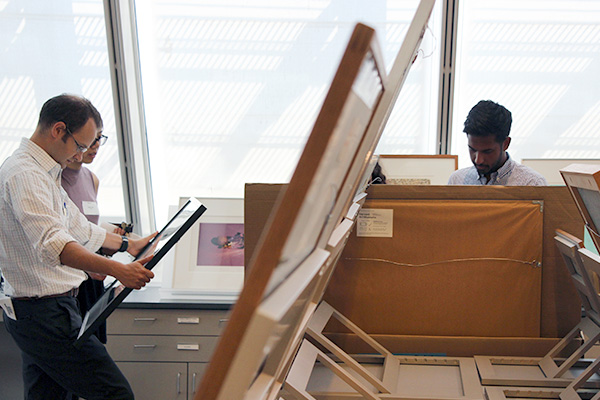Generally speaking, dorms aren’t the first place you’d think of as the home for works of fine art. But the Harvard Art Museums are helping challenge that perception. A number of students living on campus have adorned their walls with framed original artworks borrowed directly from the museums’ collections—some of them by the likes of Daumier, Joan Miró, and Andy Warhol.
The annual Student Print Rental Program gives students on campus the opportunity to rent an original work of art for their dorm room or suite. For a small fee, each student may borrow one print for the duration of the academic year, and must be responsible for its care and safety (museums staff advise on best practices).
In the fall, Art Study Center staff invited students to browse a selection of matted and framed prints in a range of media, including silkscreens, photographs, etchings, and woodcuts. In all, about 200 works were rented by the students.
“I think it’s a wonderful way to bring students into the museums and show them what we have to offer,” said Hyemi Park ’17, a classics concentrator with a secondary in the history of art and architecture and a student guide for the museums. Park was at a few of the print rental browsing and pick-up sessions, which she said were very busy, with an air of “excitement.”
“There are so many interactive ways that students can engage with the museums, and I think this is one of the most intimate ways to do it,” Park said. After all, artwork hanging on your bedroom wall is “something that you look at every day.”
Park manages Harvard Art Happens, the social media handle used on Instagram and Facebook by the museums’ Student Board, student guides, and Graduate Student Teachers. She interviewed some of her peers about how and why they made their selections. Here are a few highlights:
“I loved the intricacy of the print. It’s very complicated to be detailed when working with such a rebellious medium. I also liked the diagonal balancing both corners, it brings the piece together.” —Bruno Moguel Gallegos ’18, who is borrowing Kristina Paabus’s Notice no Notice—Sound of Silence (2006), a screenprint with gouache, graphite, and ink.
“It is really interesting and you can look at it for a long time. [My roommates and I] will never get tired of trying to figure out what all the weird little creatures are.” —Corinne Bozzini ’17, who is borrowing Art Wood’s silkscreen print Puppets (1972).
“Ed Ruscha is an artist that means a lot to me, and I recognized his style when I saw the print. It speaks to me because it elevates the quotidian to the level of high art.” —Josh Ascherman ’17, who is borrowing Edward Ruscha’s photolithograph Open (1975).
“I don’t have a specific reason as to why I chose it, but couldn’t bring myself to walk away from it. I like how big it is, but how the colors or lack of colors aren’t overwhelming. I like the combination of strong lines and soft gray details.” —Tallulah Axinn ’18, who is borrowing Patrick Caulfield’s screenprint White Pot (1976).
“The way the dull, darker colors on top contrast with the brighter ones on the bottom makes the piece pop and catches your attention.” —Alec McNiff ’18 (left), who is borrowing Takahashi Rikio’s woodcut Nest (5A) (1967); “I spent a lot of time on the water and in the Everglades as a kid from Miami, so this print reminded me of home.” —Adam Chiavacci ’18 (right), who is borrowing Judy Bergman Hochberg’s print Mangroves II (1995).


